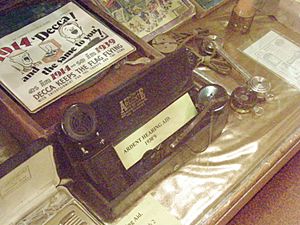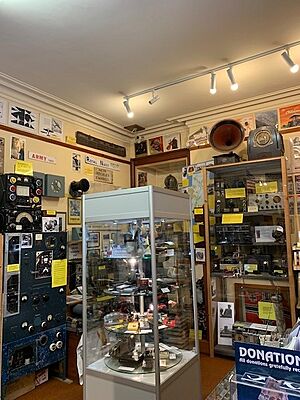Orkney Wireless Museum facts for kids
The Orkney Wireless Museum in Kirkwall, Orkney, Scotland, is a super cool place! It's filled with old radios and communication gadgets used by people at home and by the military. This amazing collection started with a man named Jim MacDonald from St Margaret's Hope. The museum shows how important wireless communication was in Orkney, especially during World War II.
Contents
Welcome to the Orkney Wireless Museum!
The Orkney Wireless Museum is located at Kiln Corner in Kirkwall. It's run completely by volunteers who love history and technology. People from all over the world, called "Friends of the Museum," help raise money to keep it going. Local volunteers make sure the museum is open every day from April to September.
Why Orkney Was Important in WWII
The museum's displays and old photographs show just how important Orkney was during World War II. The Home Fleet, a big part of the British Navy, was based nearby in Scapa Flow. Radios and Radar (a special system that uses radio waves to detect objects) were super important for both soldiers and regular people living in Orkney. They helped keep everyone safe and connected.
Talking Across the World with Ham Radio
Did you know you can talk to people all over the world using radio? This is called "amateur radio" or "ham radio." The museum has its own special call sign, GB2OWM. During the Orkney Science Festival each September, volunteers use this radio to chat with other ham radio operators worldwide. They even exchange special postcards called QSL cards to confirm their conversations!
What You Can See at the Museum
The museum has a huge collection of old radios for homes and military communication gear. Most of these items were made in the UK and the US. You can also see old advertisements and posters. A collection of photos shows what life was like for soldiers during the war. It also includes pictures of the Churchill Barriers, which were walls built in the sea to protect the naval base at Scapa Flow.
Amazing Radios and Spy Gear
Imagine listening to the radio with a device made over 100 years ago! The museum has a working crystal set from around 1912. You can even put on headphones and listen to BBC Radio Scotland! Other cool exhibits include:
- A No. 19 Tank Set, used for communication in tanks.
- Early recording machines, like the Recordon dictating machine, which used flat paper disks.
- A U-boat radio, from a German submarine.
- A spy Suitcase Radio, which looks like a normal suitcase but hides a secret radio!
- Radios used by "Y-service" operators, who listened in on enemy messages.
- Old radios made by famous companies like Emerson, Weston, Philco (from the US), and EKCO (from the UK).
Hearing the Past: Old Tech and Photos
Besides radios, you can see other interesting items that show how technology has changed. There's an example of a 1930s Ardent hearing aid, which helped people hear better long ago. The museum also has the original chart for the Scapa Flow boom defence, which was part of protecting the naval base. Plus, there's a big collection of photos showing what life was like in "Fortress Orkney" during the war.
The Story of the Museum
The Orkney Wireless Museum started because of one man's passion: Jim MacDonald. He loved radios and collected all sorts of old wireless equipment, both for homes and for the military. In 1983, people convinced him to show his amazing collection in his family home in St Margaret's Hope. He called it "An Orkney Wireless Museum."
Jim sadly passed away in 1988. But his family wanted to keep his dream alive and grow the museum. In 1990, they set up a special group called a Trust to run it. The museum became a member of the Museums and Galleries Commission of Great Britain in 1994, which showed how important and well-kept it was. It even received an award from the Royal Naval Amateur Radio Society for its work in saving and showing the history of radio in Orkney.
In 1997, the collection moved to its current home at Kiln Corner in Kirkwall. This new, bigger space meant even more of Jim's wonderful exhibits could be displayed for everyone to enjoy.
About the Founder: Jim MacDonald
James "Jim" MacDonald (1927–1988) grew up in South Ronaldsay, Orkney. He learned to be an electrician and radio repairman. As a boy, radios were becoming very popular, and he started collecting old ones that people didn't use anymore. This was the beginning of his huge collection, which includes rare and valuable radios from famous companies like Marconi and Cossor.
When World War II started in 1939, Jim worked for the War Office as a civilian at the big Naval Base in Lyness. He also worked at RAF sites like Netherbutton, where one of the world's first working Radar systems was located. This radar was super important for detecting enemy planes and ships!
After the war, Jim worked hard to collect as much relevant equipment as he could. Many operations were still top secret, and some equipment was even destroyed to prevent too many items from flooding the market. The equipment Jim collected played a vital role in important battles like the Battle of the Atlantic and in the North Sea. Every piece in his collection had seen active service, helping to protect Orkney and the country.





